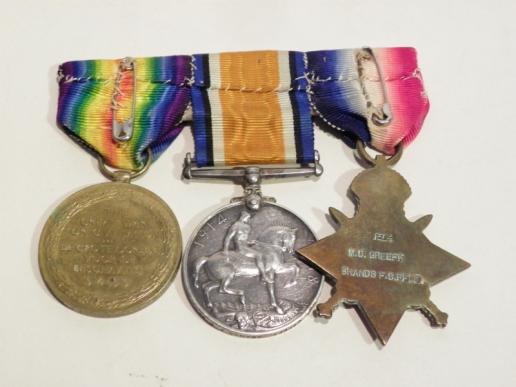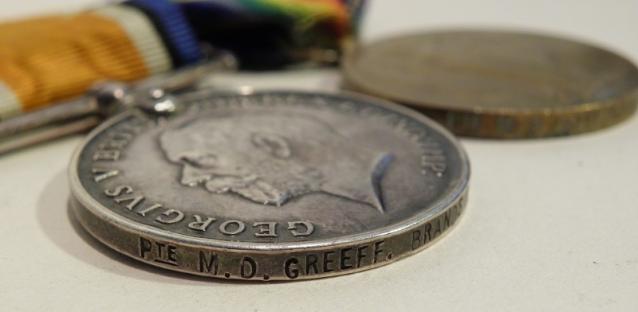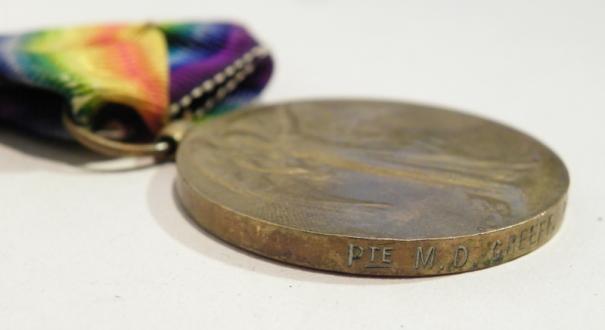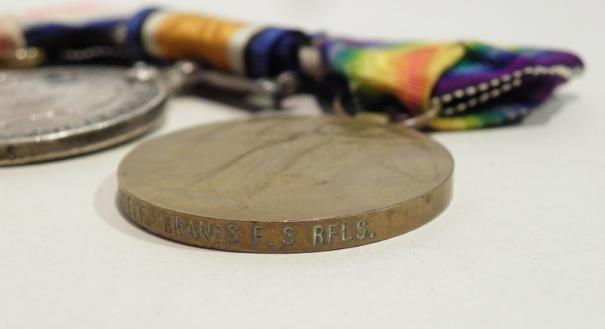Rare WW1 Trio to Greeff Brands Free State Rifles.
And interesting and scarce WW1 1914/15 star, British war and victory medal correctly named to; Private M. D. Greeff Brands Free State Rifles.
The outbreak of hostilities in Europe in August 1914 was an enormous surprise, but the government of the Union of South Africa was well aware of the significance of the common border South Africa shared with the German colony of South-West Africa. Prime Minister Louis Botha informed London that South Africa could defend itself and that the imperial garrison could depart for France; when the British government asked Botha whether his forces would invade German South-West Africa, the reply was that they could and would.
During the latter months of 1914, some prominent members of the government and armed forces tried a rebellion, stating they wanted a unified South Africa and sided with the Germans, this was short lived and soon put down by loyal forces. This was known as the Maritz rebellion, the Boer revolt and also the Five Shilling rebellion.
After the rebels were put down the South African forces along with the Brand Free State Rifles were to concentrate on the South West Africa Campaign, the conquest and occupation of German South West Africa (now Namibia). By February 1915, with the home front secure, the South Africans were ready to begin the complete occupation of the German territory. Botha in his military capacity as a senior and experienced military commander took command of the invasion. He split his command in two with Smuts commanding the southern forces while he took direct command of the northern forces.
The Brands Free State Rifles were reformed and now became the 5th Mounted Brigade in January-February 1915 and were numbered as 1-6th regiments B.V.S.S. Greeff being in the 1st Regiment. They served much of the time as front fighters and saw quite a lot of the action. After the campaign was over, South African casualties were 113 killed, 153 died of injury or illness and 263 wounded. German casualties were 103 killed, 890 taken prisoner, 37 field guns and 22 machine-guns captured.
After defeating the German force in South West Africa, South Africa occupied the colony and then administered it as a League of Nations mandate territory from 1919.
Private Greeff was then transferred to the western front, The Brigade sailed from Alexandria between 13th and 15th April 1916 and landed at Marseilles. By 23rd April, the leading units had de-trained and were arriving at Steenwerck in Flanders. The entire Brigade came under orders of the 9th (Scottish) Division, in which it replaced 28th Brigade.
Its first major engagement was the Battle of the Somme. On 2nd July 1916, moved up from Grovetown to Billon Valley, relieving 27th Brigade which had been ordered up to the battle. Moved up to relieve 89th Brigade of 30th Division in Glatz (Glatz Redoubt / Chimney Trench) sector of front line near Montauban. They came under heavy shellfire. The 4th Bn involved in fighting for Trones Wood. The entire Brigade attacked at Longueval (Delville Wood) in afternoon of 14th July 1916. Fighting of the most severe kind in the wood, in which Private William Faulds of 1st Regiment won the Victoria Cross. Only some 750 of the 3153 officers and men that entered the wood mustered when the Brigade was finally relieved on 20th July.
The Division was rebuilt with new drafts and spent most of the summer of 1916 in the Arras and Vimy areas. It re-entered Fourth Army area on the Somme in early October. The SA Brigade moved back into the front line there at High Wood on 9 October. Three days later an attack was made against Snag and Tail Trenches, just short of the Butte de Warlencourt, in appalling conditions and weather. Again, there was severe fighting that was continued with a rewnewed attack in the same area on 18 October. The cost to the South Africans in this dismal affair was 1150 casualties.
The commander of the brigade, Brigadier-General Lukin, was appointed to command of 9th (Scottish) Division on 2 December 1916.
In 1917 the brigade took part in the Battle of Arras and in the Third Battle of Ypres. In the latter battle, in a successful advance at Bremen Redoubt near Zonnebeke, Private William Hewitt of 2nd Regiment won the VC.
Possibly the most impressive feat of arms by the South African forces in the war took place in March 1918, when the Germans attacked in Operation Michael. The brigade fought a staunch defence on the first morning of the attack – 21st March 1918 – at Gauche Wood, near Villers Guislain. By 24th March they had carried out a fighting withdrawal to Marrieres Wood near Bouchavesnes and there held on, completely unsupported. They fought on until only some 100 men were left, yet it was only when ammunition ran out that the remnant, many of them wounded, surrendered.
When the enemy launched their second major offensive of 1918, on the Lys, the South African brigade – now in Flanders – was ordered to counter attack at Messines. It did so, with some success, but the enemy attack was overwhelming and over the next days the fight continued with the South Africans being pushed back from the Messines ridge and up the gentle slope to Vierstraat.
The old brigade was effectively destroyed. 1st, 2nd and 4th Regiments were temporarily merged, while other, British, units were attached to carry on the fight. The composite battalion took part in further defensive fighting, at Mount Kemmel. Later in the summer, it took part in the capture of Meteren, as the British Army executed a successful advance in Flanders.
On 11 September 1918, the brigade finally parted from 9th (Scottish) Division and moved to join the 66th (2nd West Lancashire) Division. The best known event while with this Division was the recapture of Le Cateau on 17th-18th October 1918.
By the armistice, the South Africans had suffered some 15000 casualties in France, of who one third were dead. It must have been a shock to fight in the heat of their native South Africa to then fight in the mud and western front winters.
Private Greeff Survived the war and little is known of him after the war, this is to research as well as a definite timeline of his wartime service. it is unlikely he came out of the war unscathed, but I have no information of any wounds or disease.
All three medals are in excellent condition and come on a ribbon bar.
Code: 24916
160.00 GBP







